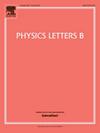Accretion, evaporation and superradiance phase diagram of (primordial) black holes and 10−21 − 1021 eV scalar, vector, tensor fields
IF 4.3
2区 物理与天体物理
Q1 ASTRONOMY & ASTROPHYSICS
引用次数: 0
Abstract
We obtain the accretion, evaporation and superradiance phase diagram of astrophysical and primordial black holes in the mass range . This black hole mass range corresponds to production of eV particles for superradiance (bosons) and evaporation (bosons and fermions). Only accretion and superradiance processes are relevant for heavy black holes, on the other hand for light black holes of primordial origin, all three processes can be relevant. We find that superradiance instability can happen even for black hole spin values as low as . Since light black holes are very unstable to these perturbations and sensitive probes of bosonic particles, a single moderately spinning BH can probe 2-9 orders of magnitude of mass parameter space depending on the nature of the perturbations that are scalar (axion), vector (dark photon and/or photon with effective mass) and spin-2. If spinning black holes are observed and superradiance is not observed, possibly due to self-interactions, we find limits on the axion/scalar decay constant and energy density. We generalize these bounds for vector and spin-2 fields.
求助全文
约1分钟内获得全文
求助全文
来源期刊

Physics Letters B
物理-物理:综合
CiteScore
9.10
自引率
6.80%
发文量
647
审稿时长
3 months
期刊介绍:
Physics Letters B ensures the rapid publication of important new results in particle physics, nuclear physics and cosmology. Specialized editors are responsible for contributions in experimental nuclear physics, theoretical nuclear physics, experimental high-energy physics, theoretical high-energy physics, and astrophysics.
 求助内容:
求助内容: 应助结果提醒方式:
应助结果提醒方式:


